Nikon F
 | |
| Overview | |
|---|---|
| Type | 35 mm SLR camera |
| Lens | |
| Lens mount | Nikon F-mount |
| Focusing | |
| Focus | manual |
| Exposure/Metering | |
| Exposure | manual |
| Flash | |
| Flash | non-ISO hot shoe, or PC socket for off-camera flash |
The Nikon F camera, introduced in April 1959,[1] was Nikon's first SLR camera.[2] It was one of the most advanced cameras of its day. Although many of the concepts had already been introduced elsewhere, it was revolutionary in that it was the first to combine them all in one camera.[3] It was produced until October 1973 and was replaced by the Nikon F2. Aspects of its design remain in all of Nikon's subsequent SLR cameras, through the current Nikon F6 film and Nikon D5 digital models (which still share its Nikon F-mount for lenses). The "F" in Nikon F was selected from the term "re-f-lex", since the pronunciation of the first letter "R" is not available in many Asian languages.[4] That tradition was carried all the way through their top line of Nikon cameras until the introduction of the Nikon D1 (digital) cameras decades later.
History
The Nikon F was enormously successful and showed the superiority of the SLR and of the Japanese camera manufacturers. It was the first SLR system to be adopted and used seriously by the general population of professional photographers, especially by those photographers covering the Vietnam War, and those news photographers using motor-driven Nikon Fs with 250-exposure backs to record the various launches of the space capsules in the Mercury, Gemini and Apollo space programs, all in the 1960s. After the introduction of the Nikon F the more expensive rangefinder cameras (those with focal plane shutters) became less attractive. It was originally priced at US$186 with 50 mm f/2 lens; in November 1963 the US price was $233 for the body with a standard prism plus $90 for the 50 mm f/2 lens or $155 for the 50 mm f/1.4.
A combination of design elements made the Nikon F successful. It had interchangeable prisms and focusing screens; the camera had a depth-of-field preview button; the mirror had lock-up capability; it had a large bayonet mount and a large lens release button; a single-stroke ratcheted film advance lever; a titanium-foil focal plane shutter; various types of flash synchronization; a rapid rewind lever; a fully removable back. It was well-made, durable, and adhered closely to the successful design scheme of the Nikon rangefinder cameras.
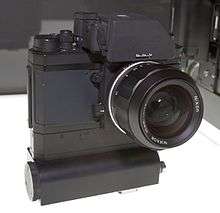
A number of these features were first introduced by other manufacturers:
- 1903: The first 35 mm camera, "the Ambrosio Camera"[5]
- 1925: Oskar Barnack's Leica mass-produces a 35 mm camera,
- 1936: The first 35 mm SLR with bayonet mounted interchangeable lenses, the Kine Exakta.
- 1949: The first camera with a pentaprism viewfinder, the Contax S.
- 1950: The first SLR with interchangeable viewfinders and focusing screens, the Exakta Varex.
- 1954: The first camera with instant-return mirror, the Asahiflex IIb.
- 1956: The first SLR with an internally activated automatic diaphragm release, the Contax F.
The Nikon F also had interchangeable backs and a viewfinder showing 100% of the image. Motor drives to advance the film, F36 (36 exposure) or F250 (250 exposure), were available, but required the replacement of the underside of the body. The F36 was not too dissimilar from the motor drive which was available for the SP.
The Nikon F evolved from a rangefinder camera, the Nikon SP.[6] "In the trial model, based on the body of the Nikon SP, the mirror box was inserted in the central part. Only the three principal components, mirror box, pentaprism and bayonet mount, were newly developed, and the other components were virtually identical to those in SP/S3."[7]
Instead of the M42 screw mount used by Pentax and other camera manufacturers, Nikon had introduced the three-claw F-mount bayonet lens mount system, which is still current in a more modified form today. The focal plane shutter had titanium foil blinds and was rated for 100,000 shutter releases. At the time, other SLRs used cloth blinds, which had the disadvantage that it was possible to burn a hole into the cloth of the shutter during mirror lock-up in bright sunlight.
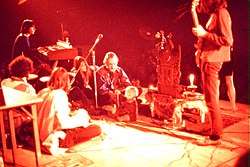
The F was also a modular system camera, with various assemblies such as the viewfinders; the focusing screens; the special 35 mm roll film 250 exposure film back and two Speed Magny film backs--one using the Polaroid 100 (now 600) type pack films, and another designed for 4x5 film accessories, including Polaroid's own 4x5 instant film back. Each of these assemblies could be fitted and removed, allowing the camera to adapt to almost any particular task. It was the first 35 mm camera offered with a successful motor drive system as opposed to a film winder. It was capable of firing up to 4 frames per second (mirror locked up) or 3 frames per section with full reflex viewing maintained.
Unlike most 35 mm camera systems the Nikon F had a wide range of lenses, covering 21 mm to 1000 mm focal length by 1962. Nikon was among the first to introduce what are known today as 'mirror lenses' – lenses with Catadioptric system designs, which allowed the light path to be folded and thus yielded lens designs that were more compact than the standard telephoto designs. Subsequent top-of-the-line Nikon models continued the F series, which eventually yielded the F6 in 2004[8] (although this camera has a fixed pentaprism—the only professional level Nikon SLR to not feature interchangeable prisms). With the introduction and continued improvements being made in digital photography, the Nikon F6 was to be the last of the flagship Nikon F-line film SLRs.
The Nikon F revolutionized the photographic market, stealing the thunder of German manufacturers Leica and Zeiss. The F also had a reputation for being extremely resilient to damage or mechanical failure. It became known as "the hockey puck". Many professional photographers, especially photojournalists, began using the F camera system. In some limited markets the camera was marketed as a "Nikkor F" due to trademark conflicts. In Germany, for example, the well established Zeiss Ikon camera line saw the "Nikon" name as too similar to their own and Nikon was forced to avoid using "Nikon" in that area. (Engraved this way, they have become highly collectable cameras in today's collector market.)

The first Nikon F Photomic viewfinder, delivered since 1962,[9] had an independent photocell. Then Nikon introduced the Photomic T (superseded by the Photomic Tn), which featured through-the-lens (TTL) metering. The final metering prism for the Nikon F, the Photomic FTn,[10] introduced in 1968, provided 60% center-weighted TTL which became the standard metering pattern for Nikon cameras for decades afterwards. Additional viewfinders included a waist-level viewer, a 6 power magnifying finder, and an "action finder" with a larger viewable area through which one could see the entire frame while wearing goggles and/or a helmet.
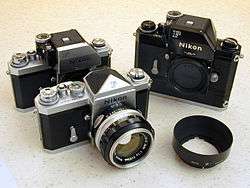
One criticism of the Nikon F was that the entire bottom and rear plate was constructed as one piece and had to be removed to reload the camera. Even so, the camera was a mainstay of professional news photographers desiring a 35 mm SLR. Specially modified Nikon FTn cameras were also taken to the lunar orbit on the Apollo J missions.[11]
The Nikon F was succeeded in 1972 by the Nikon F2 series after a production total of 862,600 bodies. Subsequent "single-digit" F cameras continued as the top of Nikon's professional line of film SLRs, through the Nikon F6 introduced in 2004.[8] The naming system changed for digital SLRs, beginning with the Nikon D1 in 1999, but Nikon's DSLRs continue to use the F lens mount introduced in 1959.
Gallery
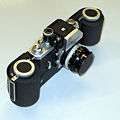 High capacity back for 30 feet (10 metres) of bulk film with the F250 motor drive
High capacity back for 30 feet (10 metres) of bulk film with the F250 motor drive F250 motor drive, as mounted (rear view)
F250 motor drive, as mounted (rear view)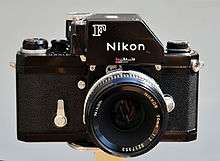 Nikon FTN with interchangeable photomic TTL metering prism
Nikon FTN with interchangeable photomic TTL metering prism A Nikon F body with detached pentaprism viewfinder, showing the focusing screen
A Nikon F body with detached pentaprism viewfinder, showing the focusing screen The first 35mm perspective control lens was introduced in 1961 for the Nikon F
The first 35mm perspective control lens was introduced in 1961 for the Nikon F the Nikon F bayonet mount
the Nikon F bayonet mount
See also
References
- ↑ Nikon F Mir
- ↑ https://expertphotography.com/10-must-have-film-cameras/
- ↑ Lothrop & Schneider, "The SLR Saga (part 2)," p 51. "in 1959, Nikon announced what was undoubtedly the most important SLR of its era–the legendary Nikon F. Although it did not embody any technological breakthroughs, it is generally credited as the cornerstone of the world's first professional caliber 35mm SLR system."
- ↑ [imaging.nikon.com/history/chronicle/history-f/ Debut of Nikon F - Design philosophy of single-lens reflex camera Nikon F system], nikon.com, retrieved 1 March 2018
- ↑ http://corsopolaris.net/supercameras/early/early_135.html
- ↑ "The Nikon," by Frank Mechelhoff Archived 2008-12-02 at the Wayback Machine.
- ↑ Design philosophy of single-lens reflex camera Nikon F system
- 1 2 "仙台ニコン | 会社紹介 | あゆみ". www.sendai-nikon.com. Retrieved 2016-08-27.
- ↑ Nikon F - Nikon F Metering Prisms and Meters Archived 2012-10-18 at the Wayback Machine. Mir
- ↑ The Nikon FTN finder Archived 2012-07-17 at the Wayback Machine.
- ↑ Camera Systems Carried on Board the Command and Service Module (CSM) on Apollo Lunar Missions
Further reading
- Comon, P. (1996): Magic Lantern Guides Classic Series: Nikon Classic Cameras Vol. 1 for F, Nikkormat Series, Fe, Fe2nd Fa (Nikon Classic Cameras), Magic Lantern Guides ( ISBN 1-883403-31-6)
- Koch, U.: Nikon F, Coeln, Peter (England) ( ISBN 3-9501443-0-7)
- Koch, U. (2003): Nikon F. The Camera, Lindemanns ( ISBN 3-9501443-1-5)
- Koch, U. (2003): Nikon F. The Lenses, Lindemanns ( ISBN 3-9501443-2-3)
- Koch, U. (2004): Nikon F. The Accessories, Lindemanns ( ISBN 3-9501443-3-1)
External links
| Wikimedia Commons has media related to Nikon F. |
- The Legend: Nikon F by luis triguez
- The Nikon F's Place in History
- The Nikon F and its System
- Nikon F Collection and Typology
- Debut of the Nikon F, by Nikon
- Comprehensive Nikon F website by Michael Liu
- Nikon F & F2 by Karen Nakamura
- A Nikon F Photomic TN Picture Gallery by Mårten Larsson
- Nikon F Photomic TN Flick pictures by Paul Bailey
Autofocus | APS-format | Nikkorex with leaf shutter | Nikomat/Nikkormat | Manual Focus with electronic features (A mode) See also: Nikon DSLR cameras | |||||||||||||||||||||||||||||||||||||||||||||||||||||||||||||||||||||||||||||||||||||||||||||||||||||||||||||||||||||||||||||||||||||||||||||||||||||||||||||||||||||||||||||||||||||||||||||||||||||||||||||||||||||||||||||||||||||||||||||||||||||||||||||||||||||||||||||||||||||||||||||||||||||||||||||||||||||||||||||||||||||||||||||||||||||||||||||||||||||||||||||||||||||||||||||||||||||||||||||||||||||||||||||||||||||||||||||||||||||||||||||||||||||||||||||||||||||||||||||||||||||||||||||||||||||||||||||||||||||||||||||||||||||||||||||||||||||||||||||||||||||||||||||||||||||||||||||||||||||||||||||||||||||||||||||||||||||||||||||||||||||||||||||||||||||||||||||||||||||||||||||||||||||||||||||||||||||||||||||||||||||||||||||||||||